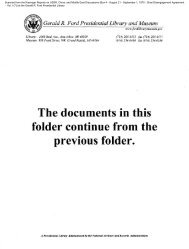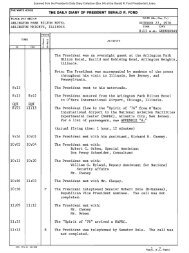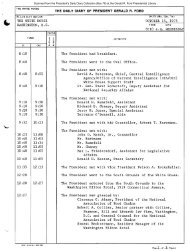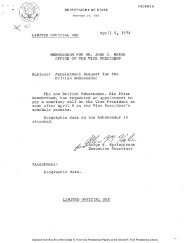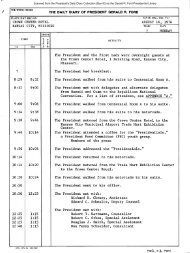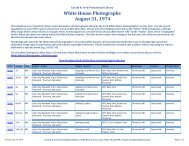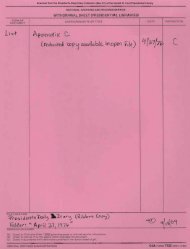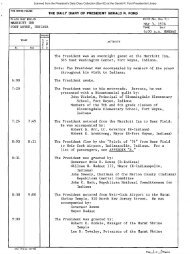October 31, 1975 - Gerald R. Ford Presidential Library and Museum
October 31, 1975 - Gerald R. Ford Presidential Library and Museum
October 31, 1975 - Gerald R. Ford Presidential Library and Museum
You also want an ePaper? Increase the reach of your titles
YUMPU automatically turns print PDFs into web optimized ePapers that Google loves.
The FEA studied 65 separate field entities. Two of the original<br />
50 fields selected by FEA contained seven separate field entities which<br />
were studied separately <strong>and</strong> one field was studied twice. An additional<br />
nine fields were selected for study after the original selection. The<br />
FEA field study program involved the preparation of 47 field reports by<br />
six contractors <strong>and</strong> 18 field reports by three Government agencies.<br />
Forty-five days were allowed for the preparation of 56 of the reports<br />
<strong>and</strong> 90 days were allowed for the preparation of nine of the reports.<br />
Neither the contractors nor the Government agencies had appreciable<br />
spare staff st<strong>and</strong>ing by awaiting commencement of the FEA field study<br />
program. Accordingly, most of the FEA field studies are not of the<br />
completely independent category discussed above. Perhaps a half dozen<br />
of the reports demonstrate thorough basic original work.<br />
Much is known <strong>and</strong> has been written about the 1arae oil <strong>and</strong> qas<br />
fields of the United States. This information is in the form of'technical<br />
papers which have been presented before professional societies<br />
or published in trade journals. Many large fields have been extensively<br />
reviewed <strong>and</strong> exhibited before various regulatory bodies. Many private<br />
field studies have received some outside distribution. Very often,<br />
large fields are studied by committees of technical people for the<br />
purpose of developing unitized ooerating plans in the secondary recovery<br />
category. When these fields involve many operators <strong>and</strong> hundreds of<br />
mineral owners, the comnlittee studies are generally accessible to those<br />
wishing to maintain extensive libraries. Finally, most of those working<br />
on the field studies have had at least some experience working for<br />
employers who have dominate positions in some of the larger fields.<br />
Most of the FEA field studies were prepared after extensive reviews<br />
of all of the available interpretative information mentioned above. Those<br />
preparing the reports usually updated these reviews to whatever extent<br />
seemed practicable. In most instances, the principal operators were<br />
visited <strong>and</strong> additional factual information was obtained. In some<br />
instances, the operators were not averse to discussing the interpretive<br />
aspects of reservoir behavior. The authors then composited the various<br />
items of information, carried out spot checks to the extent considered<br />
advisable, <strong>and</strong> estimated the required hydrocarbon volumes.<br />
Thus, the FEA field studies in most instances should be classed as<br />
'independently prepared summary reviews of available literature <strong>and</strong> data,<br />
suop1emented as necessary with oriqina1 work to make the study reasonably<br />
complete. Problems arose when a field which had never been extensively<br />
reviewed in the literature was dominated by one or two operators who<br />
declined to discuss interpretive or proprietary information. These<br />
56



